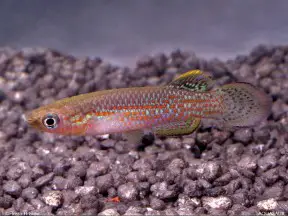Pachypanchax playfairii
Playfair's Panchax
SynonymsTop ↑
Haplochilus playfairii Günther, 1866; Panchax playfairii (Günther, 1866)
Etymology
Pachpanchax: from the Greek pachy, meaning ‘thick’, and the generic name Panchax, in reference to member species’ appearing rather like a ‘chubby’ Panchax.
playfairii: named for Lieutenant-Colonel Playfair, who presented Dr. Günther with the type series.
Classification
Order: Cyprinodontiformes Family: Aplocheilidae
Distribution
Type locality is given simply as ‘Seychelles’ and this species was originally endemic to the Granitic Seychelles, i.e., those islands in the centre of the group composed chiefly of granite rock.
A translocated population now exists on Zanzibar while in the Seychelles it’s known from the islands of Mahé, Praslin, Silhouette and La Digue.
This species’ conservation status is currently in need of evaluation.
Habitat
Unlike the outer coral-based islands the Granitic Seychelles are covered in tropical moist forest with a number of endemic plant and animal species, and P. playfairii inhabits small streams under forest cover.
It’s the only purely freshwater fish species native to the Seychelles although the endemic microdesmid Parioglossus multiradiatus also occurs in the lower reaches of some streams while it appears that some non-natives have become established, in particular the tilapia Oreochromis mossambicus.
Maximum Standard Length
90 – 100 mm.
Aquarium SizeTop ↑
An aquarium with base dimensions of ∗ cm should be the absolute minimum considered.
Water Conditions
Temperature: 18 – 24 °C
pH: 6.0 – 8.0
Hardness: 90 – 268 ppm
Diet
An unfussy feeder and will accept quality dried products as well as live and frozen fare, including earthworms of its own body length as well as bloodworm, Tubifex, Daphnia, etc.
Wingless fruit flies of the genus Drosophila and tiny crickets are also excellent foods if gut-loaded prior to use.
Behaviour and CompatibilityTop ↑
Relatively peaceful although much smaller fishes are likely to be predated on, and given its conservation status it’s perhaps best maintained alone.
It can be maintained in a group provided the aquarium contains sufficient refuges.
Rival males will regularly fight amongst themselves but serious physical damage is rare.
Sexual Dimorphism
Males grow larger than females and develop more-extended fins as they mature, plus they are far more colourful than females with a series of reddish-brown spots on the flanks.
Reproduction
If conditions are suitable this species is not difficult to breed and will deposit its eggs among live plants, aquatic mosses, synthetic mops, etc.
It’s perhaps best spawned in a group which can be left in situ and in a well-decorated set-up some fry may escape predation by the adults, otherwise eggs or medium can be removed to a separate container for incubation.
NotesTop ↑
This species can be immediately told apart from all congeners by the presence of raised scales on the dorsal surface of most adult males and a black ocellus in the dorsal-fin of females.
The genus Pachypanchax is endemic to Madagascar and the granitic Seychelles with one recently translocated population known from the island of Zanzibar.
Following Loiselle (2006) it is diagnosed as follows: maxilla relatively immobile, bound at its posterior end to the preorbital by a fold of skin; premaxillary ascending processes flat and broad, tapered posteriorly and not overlapping in the midline; presence of a single pair of tubular nares; refelective pineal spot absent; squamation in anterior portion of body of the ‘E-type’ (sensu Hoedemann, 1958) with prominent ‘H-type’ scales; lateral line not present although some large specimens possess a shallow pit in the centre of some scales; papillae on scales and fin rays absent; haemal arches not expanded and haemal spines without pleural ribs; in adults hypural plates fused to form a hypural fan, with the join lines visible in juveniles; caudal-fin rounded to truncate with the central rays never extended; basal third to three-quarters of caudal-fin heavily-scaled, the scales in straight rows one scale wide, each series on the interspace between two rays; caudal-fin without a median lobe; filamentous extensions of the dorsal and caudal-fins variably present in males; dark gular bar variably present; no cross bars on the body; no dark spot at base of caudal-fin in males, variably present in females.
The position of the family Aplocheilidae within the Order Cyprinodontiformes and its constituent members appears to be in question.
It’s generally been considered a natural, monophyletic lineage comprising species from India, South East Asia, The Seychelles and Madagascar but the results of a phylogentic analysis by Hertwig (2008) suggest that the genus Aplocheilus represents the basal sister group to all other Cyprinodontiformes with Pachypanchax forming a separate, less-ancient evolutionary lineage.
The author stopped short of suggesting new family groups for the two genera, however, and both remain in Aplocheilidae at time of writing.
References
- Günther, A., 1866 - Catalogue of fishes in the British Museum v. 6: i-xv + 1-368
Catalogue of fishes in the British Museum. Catalogue of the Physostomi, containing the families Salmonidae, Percopsidae, Galaxidae, Mormyridae, Gymnarchidae, Esocidae, Umbridae, Scombresocidae, Cyprinodontidae, in the collection of the British Museum. - Hertwig, S. T., 2008 - Zoologica Scripta 37(2): 141-174
Phylogeny of the Cyprinodontiformes (Teleostei, Atherinomorpha): the contribution of cranial soft tissue characters. - Loiselle, P. V., 2006 - Zootaxa 1366: 1-44
A review of the Malagasy Pachypanchax (Teleostei: Cyprinodontiformes, Aplocheilidae), with descriptions of four new species. - Murphy, W. J. and G. E. Collier, 1997 - Molecular Biology and Evolution 14(8): 790-799
A molecular phylogeny for aplocheiloid fishes (Atherinomorpha, Cyprinodontiformes): the role of vicariance and the origins of annualism. - Myers, G. S., 1933 - American Museum Novitates No. 592: 1 p.
Pachypanchax, a New Genus of Cyprinodont Fishes from The Seychelles Islands and Madagascar.



